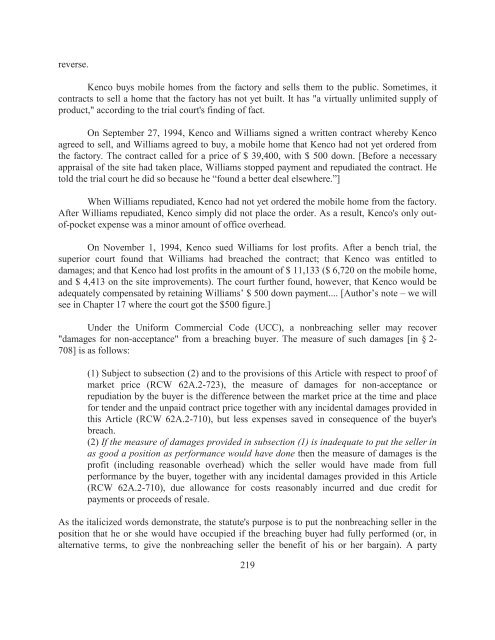Sales and Leases - A Problem-based Approach, 2016a
Sales and Leases - A Problem-based Approach, 2016a
Sales and Leases - A Problem-based Approach, 2016a
You also want an ePaper? Increase the reach of your titles
YUMPU automatically turns print PDFs into web optimized ePapers that Google loves.
everse.<br />
Kenco buys mobile homes from the factory <strong>and</strong> sells them to the public. Sometimes, it<br />
contracts to sell a home that the factory has not yet built. It has "a virtually unlimited supply of<br />
product," according to the trial court's finding of fact.<br />
On September 27, 1994, Kenco <strong>and</strong> Williams signed a written contract whereby Kenco<br />
agreed to sell, <strong>and</strong> Williams agreed to buy, a mobile home that Kenco had not yet ordered from<br />
the factory. The contract called for a price of $ 39,400, with $ 500 down. [Before a necessary<br />
appraisal of the site had taken place, Williams stopped payment <strong>and</strong> repudiated the contract. He<br />
told the trial court he did so because he “found a better deal elsewhere.”]<br />
When Williams repudiated, Kenco had not yet ordered the mobile home from the factory.<br />
After Williams repudiated, Kenco simply did not place the order. As a result, Kenco's only outof-pocket<br />
expense was a minor amount of office overhead.<br />
On November 1, 1994, Kenco sued Williams for lost profits. After a bench trial, the<br />
superior court found that Williams had breached the contract; that Kenco was entitled to<br />
damages; <strong>and</strong> that Kenco had lost profits in the amount of $ 11,133 ($ 6,720 on the mobile home,<br />
<strong>and</strong> $ 4,413 on the site improvements). The court further found, however, that Kenco would be<br />
adequately compensated by retaining Williams’ $ 500 down payment.... [Author’s note – we will<br />
see in Chapter 17 where the court got the $500 figure.]<br />
Under the Uniform Commercial Code (UCC), a nonbreaching seller may recover<br />
"damages for non-acceptance" from a breaching buyer. The measure of such damages [in § 2-<br />
708] is as follows:<br />
(1) Subject to subsection (2) <strong>and</strong> to the provisions of this Article with respect to proof of<br />
market price (RCW 62A.2-723), the measure of damages for non-acceptance or<br />
repudiation by the buyer is the difference between the market price at the time <strong>and</strong> place<br />
for tender <strong>and</strong> the unpaid contract price together with any incidental damages provided in<br />
this Article (RCW 62A.2-710), but less expenses saved in consequence of the buyer's<br />
breach.<br />
(2) If the measure of damages provided in subsection (1) is inadequate to put the seller in<br />
as good a position as performance would have done then the measure of damages is the<br />
profit (including reasonable overhead) which the seller would have made from full<br />
performance by the buyer, together with any incidental damages provided in this Article<br />
(RCW 62A.2-710), due allowance for costs reasonably incurred <strong>and</strong> due credit for<br />
payments or proceeds of resale.<br />
As the italicized words demonstrate, the statute's purpose is to put the nonbreaching seller in the<br />
position that he or she would have occupied if the breaching buyer had fully performed (or, in<br />
alternative terms, to give the nonbreaching seller the benefit of his or her bargain). A party<br />
219


















